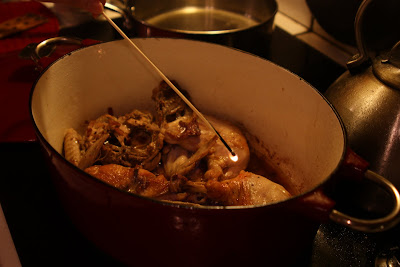
I've made coq au vin a couple times before. The first time I used the recipe from America's Test Kitchen's "The Best Recipe" cookbook, and I was very pleased with it. I also tried to make "coq au riesling" using riesling instead of red wine, and I thought that was very good as well. But I realized that I have not made a "true" coq au vin until I tried Julia Child's recipe just yesterday.
Having watched "Julie and Julia" recently, I decided to purchase Julia Child's Mastering the Art of French Cooking. My cousin Sara had tried the coq au vin from this book and swears by it, so I figured it was a good recipe to try on a cold winter weekend. Of course, given that I'm still on a diet, I figured that a this dish would be a bit better (just a tad) than others I could try. I'm sure the copious amounts of butter helped negate most of that, but at least I'm braising chicken instead of beef or lamb.
I have to admit, Julia's recipe is a lot more involved than the other recipes I've tried. It required braising the onions and sautéing the mushrooms separately. But I also get to do fun stuff like flambé some cognac on top of the chicken. It was a lot of work, but I firmly believe that it was all worth it, and this was the best coq au vin that I've ever made. I'm glad that I tried the first two recipes, since it gave me more skills and experience to attempt this more complicated recipes. It also led me to more deeply appreciate the perfection of this one.
Since the coq au vin itself already had a lot of calories, I figure I'd save myself a bit of points and trouble by having a simple side of boiled potatoes. We just peeled and boiled some small golden potatoes and served them alongside the coq au vin. I found that I actually prefer this side than the buttered egg noodles that I used to have. The soft potatoes readily absorbed the gravy-like sauce, and since the sauce was already so rich, it did not need the additional butter or cream that is usually added to mashed potatoes. It did its job, which was to let the main dish shine, and give me some carbs that I was bound to crave. We also had some fresh French bread to help sop up the sauce, and some French butter that I bought from Milk Pail a while back.
For our drinking wine, we stayed in the same region, and drank a Clos de L'Oratoire Des Papes Châteauneuf-du-Pape 2006. Since it was from the same wine region and used the same grape varietals, it went perfectly with the wine sauce of the coq au vin. Of course, as a Châteauneuf-du-Pape, this has distinctly higher quality than our cooking wine. It was a bargain from Costco (sadly never to be seen again), and it was the perfect match to this meal.
This dish is definitely more "rustic" in appearance and presentation than some other French dishes that I've made, but it is definitely not lacking in flavor. I'm very much looking forward to trying Julia's other recipes!

Getting ready to flambé the cognac

The finished product

Clos de L'Oratoire Des Papes Châteauneuf-du-Pape 2006

Table presentation
No comments:
Post a Comment